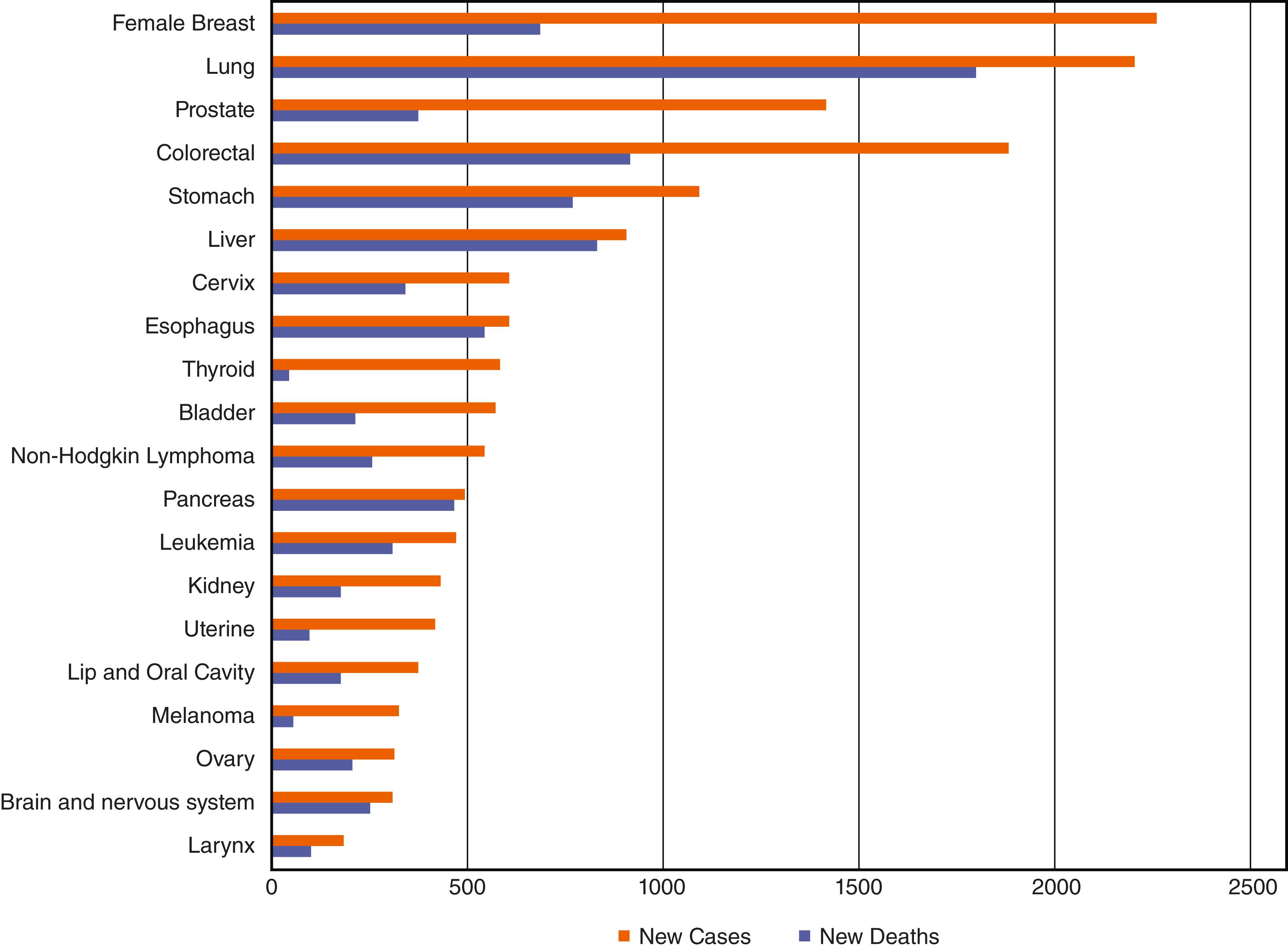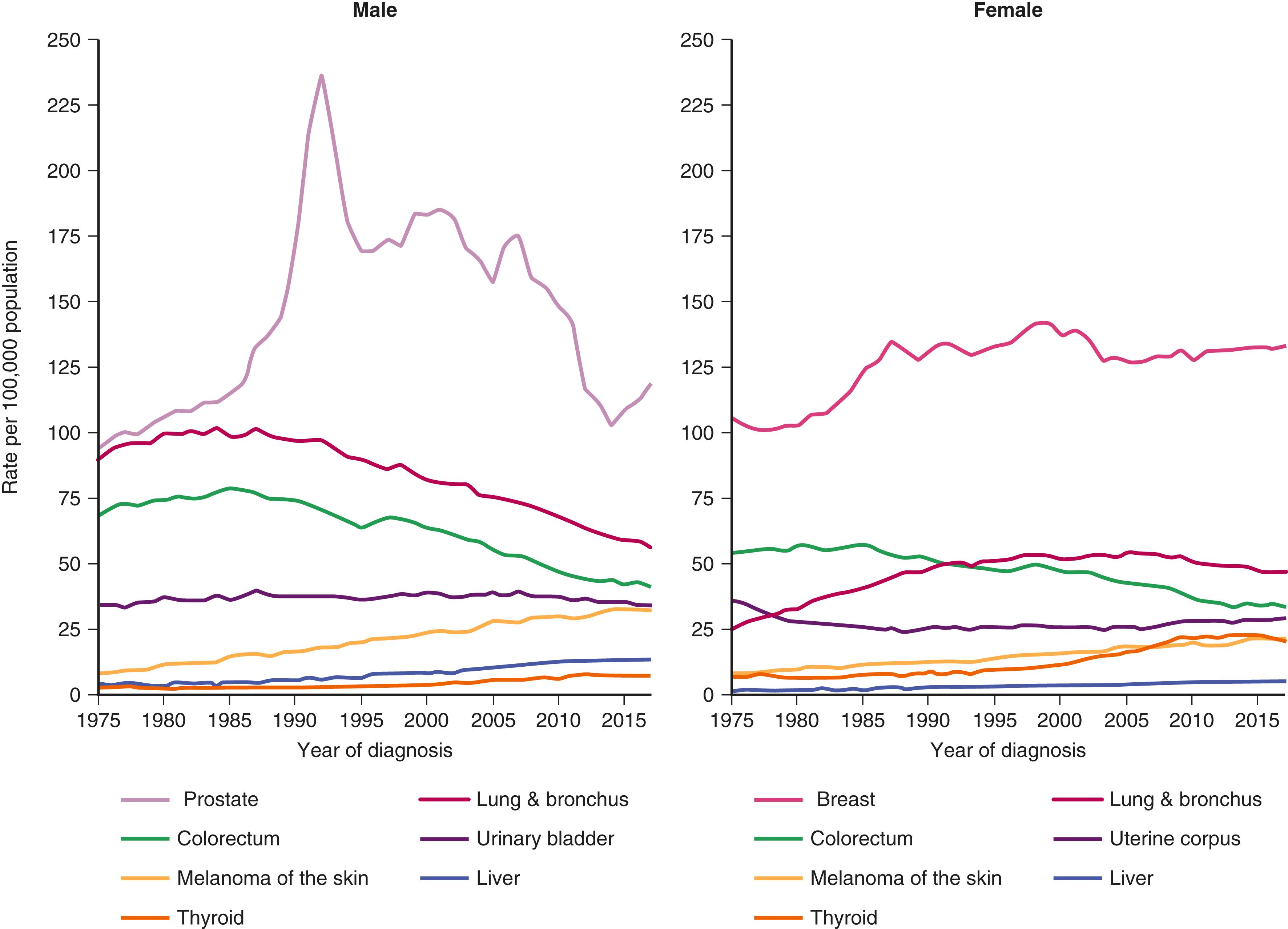Physical Address
304 North Cardinal St.
Dorchester Center, MA 02124
Cancer is a major public health concern worldwide. The World Health Organization (WHO) estimates that cancer is the first or second leading cause of death before age 70 years in the majority of countries. In 2020, 19.3 million new cases of cancer were diagnosed globally, and almost 10 million deaths were attributable to cancer ( Fig. 165-1 ). Among women, breast cancer (24.5%) is the leading cause of incident cancer followed by colorectal cancer (9.4%), and breast cancer (15.5%) is the leading cause of cancer mortality followed by lung cancer (13.7%). Among men, lung cancer (14.3%) is the leading cause of incident cancer followed by prostate cancer (14.1%), and lung cancer (21.5%) is the leading cause of cancer mortality followed by liver cancer (10.5%). The burden of cancer varies substantially by geographic region and is impacted by factors such as the age of the population, the prevalence of cancer risk factors, screening and treatment practices, and a country’s social and economic development. For example, the incidence and mortality of cervical cancer ( Chapter 184 ) is quite low in high-income countries compared with low-income countries because of cervical cancer screening and vaccination for human papillomavirus.

In the United States, cancer is the second leading cause of death after heart disease. In 2020, more than 1.8 million new cases of cancer were diagnosed, and over 600,000 deaths were attributed to cancer. Over the past 50 years, the United States has experienced substantial changes in the incidence of several types of cancer as a reflection of patterns of exposure to risk factors as well as access to and utilization of cancer screening ( Fig. 165-2 ). For example, the dramatic increase in the incidence of prostate cancer ( Chapter 186 ) in the 1990s reflected widespread prostate-specific antigen (PSA) testing in men and the resulting detection of asymptomatic disease. This increase was then followed by a dramatic decline in the reported incidence of prostate cancer in 2007 to 2014, largely attributable to changes in the screening guidelines of the United States Preventive Task Force (USPTF), which recommended against routine PSA screening because of concerns regarding overdiagnosis and overtreatment. Similar to prostate cancer, the incidence of breast cancer ( Chapter 183 ) increased in the late 1980s with widespread adoption of mammographic screening. However, incidence rates for breast cancer have remained relatively stable, with slight increases observed in the last 20 years, thought to be attributable to continued increases in body mass index and trends in reproductive patterns (e.g., later age at first birth and lower parity). The incidence rates for colorectal cancer ( Chapter 179 ) have been declining for both men and women since the mid-1980s, likely reflecting colorectal cancer screening practices that can detect precancerous lesions and prevent cancers from occurring. Incidence rates for lung cancer ( Chapter 177 ) closely mirror smoking patterns in the population, although the decline in incidence rates is more pronounced in men than in women. Some of this sex difference may be related to differences in the initiation and cessation of smoking, but a greater percentage of lung cancers in women occur in nonsmokers.

Cancer death rates declined by 33% in the U.S. between 1991 and 2020. Nevertheless, by 2040, estimates suggest that breast cancer will be the most common cancer in the United States, followed by melanoma, lung cancer, and colorectal cancer. In terms of cancer death, lung cancer is projected to remain first, followed by pancreatic cancer, liver and biliary cancer, colon cancer, and breast cancer.
Increasing age is an important risk factor for most cancers, with more than one-third of new cancers in the United States occurring in people age 75 years or older. Age likely represents the accumulation of biologic changes that influence carcinogenesis ( Chapter 166 ). However, these biologic changes occur at different rates in different people depending on their underlying genetics and exposures across the life course. Additionally, cancers at different sites have unique patterns of incidence across the age continuum.
For cancers that occur in both men and women, cancer incidence rates tend to be higher in men ( Fig. 165-2 ). At least some of these sex differences may be attributable to differences in the prevalence of relevant risk factors. For example, the prevalence of smoking has changed over time, but current smoking and smoking-related cancers continue to be higher in men in most countries.
Cancer incidence and mortality rates vary by race and ethnicity. These differences are multifactorial and reflect differences in risk factors and access to high-quality preventive care, screening, and cancer treatments. Across all cancer sites, Black men in the United States have about a 20% higher cancer death rate than do White men. Similarly, Black women in the United States have about a 12% higher death rate than do White women, despite having a lower incidence rate. Black and Hispanic patients are often diagnosed at later stages of cancer, in part reflecting lower rates of screening. Overall cancer mortality rates mask disparities for specific cancers. For example, although Hispanic and Asian individuals have lower overall cancer mortality, their incidence and mortality of liver cancer are higher than in the White population.
Potentially modifiable environmental and lifestyle risk factors are major contributors to the development of cancer.
Tobacco use ( Chapter 363 ), and in particular cigarette smoking, is a leading cause of death from cancer. In the United States, almost 30% of cancer deaths are estimated to be attributable to tobacco smoking. Strong evidence links tobacco smoking as a cause for a number of cancers, including lung, oral cavity, nasal cavity, nasopharynx, oropharynx, hypopharynx, larynx, esophagus, stomach, pancreas, liver, kidney, ureter, bladder, and cervix, as well as myeloid leukemia. Chewing tobacco also markedly increases the risk of oral and pharyngeal cancers. Significant advances in tobacco control have resulted in dramatic declines in the prevalence of smoking. Despite these successes, an estimated 22% of the global adult population smokes tobacco. Smoking rates vary widely by region and sex. China has the highest prevalence of adult male smoking (29%), whereas the United States has the highest prevalence of adult female smoking (10%).
Despite success in efforts to reduce cigarette smoking, the emergence of new tobacco products (e.g., vapes, sheesha, flavored tobacco products) has created new public health and equity issues. Additionally, tobacco control has been less successful in specific segments of the population, especially related to sexual orientation and gender identity ( Chapter 215 ).
Become a Clinical Tree membership for Full access and enjoy Unlimited articles
If you are a member. Log in here